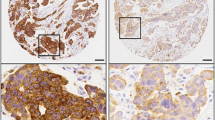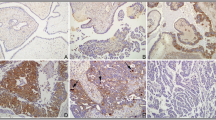Abstract
Carbonic anhydrase IX (CAIX) is a strictly membranous expressed metalloenzyme involved in cell adhesion, pH homeostasis, and cancer progression. This study was designed to assess the role of CAIX in primary ovarian cancer. Two hundred five well-characterized primary ovarian carcinomas were analyzed on a tissue microarray. CAIX expression was determined by immunohistochemistry using a four-step scoring system. Moderate and strong membranous CAIX expression was found in 37 out of 205 (18%) of all assessable ovarian cancer specimens. High levels of CAIX expression were related to mucinous and endometrioid phenotype of ovarian carcinomas (p < 0.05). There was no association between CAIX overexpression and tumor stage, grading, and mitotic count of ovarian carcinomas (p > 0.05). In univariate Cox regression analysis, advanced tumor stage (p < 0.01), high tumor grade (p = 0.017), high mitotic count (p = 0.025), and high CAIX expression levels (p = 0.031) were correlated to shorter overall patient survival. High pT stage (p = 0.036) and CAIX overexpression were connected to poor clinical outcome in endometrioid ovarian carcinomas. Multivariate Cox regression hazard analysis comprising tumor stage, tumor grade, mitotic count, and CAIX expression revealed pT2/3 stage and CAIX overexpression (scores 2 and 3) as independent prognostic markers in ovarian cancer (p < 0.01, each) as well as in the subgroup of endometrioid carcinomas (p < 0.05, each). In conclusion, CAIX is overexpressed in a substantial proportion of mucinous and endometrioid ovarian carcinomas and connected to poor patient outcome. Our data support the potential therapeutic benefit of newly developed targeting antibodies in advanced ovarian cancer.



Similar content being viewed by others
References
Zavada J, Zavadova Z, Pastorekova S et al (1993) Expression of MaTu-MN protein in human tumor cultures and in clinical specimens. Int J Cancer 54:268–274
Potter C, Harris AL (2004) Hypoxia inducible carbonic anhydrase IX, marker of tumour hypoxia, survival pathway and therapy target. Cell Cycle 3:164–167
Robertson N, Potter C, Harris AL (2004) Role of carbonic anhydrase IX in human tumor cell growth, survival, and invasion. Cancer Res 64:6160–6165
Kaluz S, Kaluzova M, Liao SY et al (2009) Transcriptional control of the tumor- and hypoxia-marker carbonic anhydrase 9: a one transcription factor (HIF-1) show? Biochim Biophys Acta 1795:162–172
Ivanov S, Liao SY, Ivanova A et al (2001) Expression of hypoxia-inducible cell-surface transmembrane carbonic anhydrases in human cancer. Am J Pathol 158:905–919
Hussain SA, Ganesan R, Reynolds G et al (2007) Hypoxia-regulated carbonic anhydrase IX expression is associated with poor survival in patients with invasive breast cancer. Br J Cancer 96:104–109
Klatte T, Seligson DB, Rao JY et al (2009) Carbonic anhydrase IX in bladder cancer: a diagnostic, prognostic, and therapeutic molecular marker. Cancer 115:1448–1458
Loncaster JA, Harris AL, Davidson SE et al (2001) Carbonic anhydrase (CA IX) expression, a potential new intrinsic marker of hypoxia: correlations with tumor oxygen measurements and prognosis in locally advanced carcinoma of the cervix. Cancer Res 61:6394–6399
Swinson DE, Jones JL, Richardson D et al (2003) Carbonic anhydrase IX expression, a novel surrogate marker of tumor hypoxia, is associated with a poor prognosis in non-small-cell lung cancer. J Clin Oncol 21:473–482
Pfisterer J, du Bois A (2007) [Therapeutic standards for ovarian cancer]. Pathologe 28:222–228
Hynninen P, Vaskivuo L, Saarnio J et al (2006) Expression of transmembrane carbonic anhydrases IX and XII in ovarian tumours. Histopathology 49:594–602
Simon R, Mirlacher M, Sauter G (2004) Tissue microarrays. Biotechniques 36:98–105
Partridge EE, Phillips JL, Menck HR (1996) The National Cancer Data Base report on ovarian cancer treatment in United States hospitals. Cancer 78:2236–2246
Bubendorf L, Nocito A, Moch H et al (2001) Tissue microarray (TMA) technology: miniaturized pathology archives for high-throughput in situ studies. J Pathol 195:72–79
Ruiz C, Seibt S, Al Kuraya K et al (2006) Tissue microarrays for comparing molecular features with proliferation activity in breast cancer. Int J Cancer 118:2190–2194
Torhorst J, Bucher C, Kononen J et al (2001) Tissue microarrays for rapid linking of molecular changes to clinical endpoints. Am J Pathol 159:2249–2256
Kurman RJ, Shih Ie M (2008) Pathogenesis of ovarian cancer: lessons from morphology and molecular biology and their clinical implications. Int J Gynecol Pathol 27:151–160
Ruan K, Song G, Ouyang G (2009) Role of hypoxia in the hallmarks of human cancer. J Cell Biochem 107:1053–1062
Kaluz S, Kaluzova M, Chrastina A et al (2002) Lowered oxygen tension induces expression of the hypoxia marker MN/carbonic anhydrase IX in the absence of hypoxia-inducible factor 1 alpha stabilization: a role for phosphatidylinositol 3′-kinase. Cancer Res 62:4469–4477
Kopacek J, Barathova M, Dequiedt F et al (2005) MAPK pathway contributes to density- and hypoxia-induced expression of the tumor-associated carbonic anhydrase IX. Biochim Biophys Acta 1729:41–49
Cantley LC, Neel BG (1999) New insights into tumor suppression: PTEN suppresses tumor formation by restraining the phosphoinositide 3-kinase/AKT pathway. Proc Natl Acad Sci U S A 96:4240–4245
Shayesteh L, Lu Y, Kuo WL et al (1999) PIK3CA is implicated as an oncogene in ovarian cancer. Nat Genet 21:99–102
Zavada J, Zavadova Z, Zat’ovicova M et al (2003) Soluble form of carbonic anhydrase IX (CA IX) in the serum and urine of renal carcinoma patients. Br J Cancer 89:1067–1071
Mulders P, Bleumer I, Debruyne F et al (2004) Specific monoclonal antibody-based immunotherapy by targeting the RCC-associated antigen carbonic anhydrase-IX(G250/MN). Urologe A 43(Suppl 3):S146–S147
Bauer S, Oosterwijk-Wakka JC, Adrian N et al (2009) Targeted therapy of renal cell carcinoma: synergistic activity of cG250-TNF and IFNg. Int J Cancer 125:115–123
Stillebroer AB, Mulders PF, Boerman OC et al (2010) Carbonic anhydrase IX in renal cell carcinoma: implications for prognosis, diagnosis, and therapy. Eur Urol 58:75–83
Wilex: Phase III ARISER Study (Adjuvant RENCAREX®Immunotherapy Phase III trial to Study Efficacy in non-metastatic RCC). http://www.wilex.de/R&D/RENCAREX_PhaseIII.htm
Conflict of interest statement
We declare that we have no conflict of interest.
Author information
Authors and Affiliations
Corresponding author
Rights and permissions
About this article
Cite this article
Choschzick, M., Oosterwijk, E., Müller, V. et al. Overexpression of carbonic anhydrase IX (CAIX) is an independent unfavorable prognostic marker in endometrioid ovarian cancer. Virchows Arch 459, 193–200 (2011). https://doi.org/10.1007/s00428-011-1105-y
Received:
Revised:
Accepted:
Published:
Issue Date:
DOI: https://doi.org/10.1007/s00428-011-1105-y




